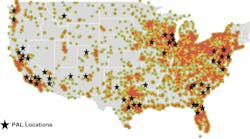Proper use of in-cab "windows into engines" helps drivers lower vehicle cost per mile.
Advanced diesels supply equipment managers with reams of useful information for monitoring the health and well being of the engine, as well as for building vehicle and driver histories. Today, these tasks are accomplished primarily through retrieval of data stored in the engine's electronic control unit (ECU). After being downloaded, the data is reconstructed on a PC.
But much of this information can also be shared with the driver through information displays developed by Class 8 engine makers. Four of these systems, which are wired to engine ECUs and mounted in or on dashboards, are available: Cummins' RoadRelay, Detroit Diesel's Pro Driver, Caterpillar's ID, and Mack's Co-Pilot.
The optional devices, which carry a price tag of about $500, have been most impressive in helping drivers improve their fuel economy. The displays show current trip or target mpg, and over a period of time the advantages of good shifting and cruising habits manifest themselves in the form of better fuel economy. By checking incentive information on other screens, drivers can make sure they remain within company overspeed and idle-time percentage limits.
Since the devices track truck mileage, they can also be put to use for some non-engine-related maintenance. For instance, a fleet can program a brake-reline interval into a display, and a signal will be flashed to the driver when that interval is reached.
With this capability, displays can help fleets better control routine maintenance costs. But they also should reduce the expense of unscheduled maintenance by providing easy-to-understand alerts and fault information, as well as sensor and performance data. Diagnostic information for active fault descriptions is excellent in all the displays.
According to Wayne Wissinger, manager of vehicle integration, Mack Trucks, there are quite a few operational savings that can be won with these "windows into engines." During a tech session on the efficient use of electronic data at the summer TMC meeting in Tucson, he compared and contrasted characteristics of each of the four devices.
Wissinger explained that after a power-up sequence in which the systems self-check, the driver can select trip, mpg, and sensor information as needed. "There are interrupt screens that will warn drivers of hard-braking or speeding incidents, as well as active engine faults and other problems as they occur."
From that point on, though, the devices are far from identical. Each has its own array of strengths and weaknesses. In fact, this is because software that controls their operation is quite different. While all four displays provide current trip info, only two offer this data sorted by state, and one offers no driver segment/leg information.
With regard to fundamental information such as trip miles, hours of running, and fuel burned, the devices are quite similar. But one offers no PTO fuel and hours, nor does it display trip average speed.
All four displays give current trip mpg data. But when it comes to instantaneous mpg, life-of-vehicle mpg, or mpg trends, none of the displays can provide them all. And only two supply information on engine over-revving.
All devices display the basic maintenance-due message, but the number of items that could be tracked varies from 1 to 14. While all four displays relay active fault codes, only one displays inactive trip faults.
In the near future, the displays will be larger, easier to read, and have more one-touch buttons to give access to frequently accessed screens. More ECU information is also going to be available.
Wissinger says that, for now, "displays work best when they are used with the same engine OEM. Since none have the exact same features as their counterparts, make sure the one you get most closely meets your needs. Remember, too, that some displays need to be programmed with service tools, while others are stand-alone reprogrammable."


